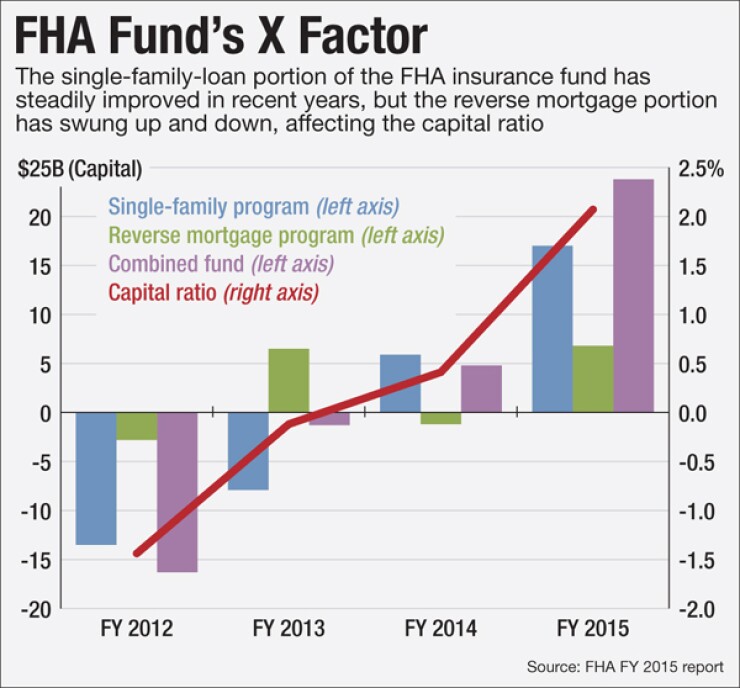-
Higher mortgage rates and other macroeconomic challenges may dampen lending under the Federal Housing Administration's single-family program, but they will produce a net benefit to the insurance fund. Here's why.
November 20

Mission accomplished … or is it?
The Federal Housing Administration has celebrated the fact that its insurance fund had a capital ratio of nearly 2.1% in the recently concluded fiscal year; it was the first time the ratio had surpassed the congressionally mandated 2% level since 2008.
But a relatively small, highly volatile component — the agency's reverse mortgage portfolio — played a big role in bolstering the fund.
"While only 10% of the overall portfolio," the reverse mortgage program "has been responsible for a large part of the [fund's] value swing in recent years, which is something that policymakers might want to be looking at," said David Stevens, chief executive of the Mortgage Bankers Association.
Overall the fund was worth $23.8 billion, which was roughly $9 billion above projections for 2015, according to a report to Congress on the FHA fund's health issued last week. Of that margin, $8 billion stemmed from the reverse mortgage program, FHA chief Ed Golding told reporters in discussing the report.
Where did it come from?
"The health of the [FHA] fund is bolstered by improvements in the [reverse mortgage] portfolio attributable to changes in the actuarial forecasting of home values and interest rates, and recent policies such as changes to up-front [mortgage-insurance-premium] pricing and new rules requiring a financial assessment for all borrowers," National Reverse Mortgage Lenders Association Chief Executive Peter Bell said in a written statement responding to the news.
The results could represent a turning point for the FHA's reverse mortgage program. Since the portfolio was moved from a different fund to the current fund in 2008, critics have said it should be broken back out. These criticisms stem in part from the hefty influence the portfolio has had on perceptions of the other program covered by the FHA fund — the much larger single-family mortgage program.
"Market observers generally look to the [fund's] capital ratio as a proxy for the health of the [single-family] portfolio, primarily because [it] makes up $1 trillion of the $1.1 trillion" combined portfolio covered by the fund, the report to Congress said. "However, significant swings in value over the last four years reflect the [reverse mortgage] portfolio's outsized impact" on the value of the fund.
That means the reverse mortgage portfolio also has a strong influence on overall policy affecting the fund, including premium reductions.
Actuaries measured the reverse mortgage portfolio's value at $6.8 billion in fiscal 2015, but they had projected that it would move to a loss of $1.1 billion from the previous year's $1.2 billion loss. Overall, the report said that much of the difference between the actual and projected values for the fund in recent years have rested on how difficult it is for them to predict fluctuations in the reverse mortgage portfolio, calling its behavior "almost random."
In particular, the portfolio displays a high sensitivity to "seemingly small" changes in economic conditions including interest rate and home price projections, the report said.
And with an interest rate hike likely on the horizon, the actuary noted that there is a strong chance for projected futures losses in the reverse mortgage portfolio's value that could again outweigh positive movement in the single-family portfolio.
The reverse mortgage program, "with its wide swings in capital as a result of economic forecasts, can result in misleading conclusions about the solvency of the [fund] — positively or negatively," Brian Chappelle, a founding partner of Potomac Partners
Yet, while it may be the source of many headaches when it comes to predicting the future health of the fund, for now the FHA's hands are tied.
Splitting out the reverse mortgage portfolio or similar actions "would take a statutory change," Golding said.





